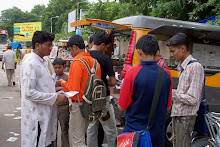The Quint: Bhanu Damjia: Sunday, March 26, 2017.
Long suppressed, India’s office of the President can now be the country’s saviour. From the start of the republic, the much stronger office of the Prime Minister started diminishing the presidency.
Contrary to the Constituent Assembly’s intentions of establishing an exalted President, the office was reduced to a mere figurehead within 25 years of the Constitution’s adoption.
It doesn’t befit a great nation to have a rubberstamp as one of its two top officials. And it’s definitely not a smart way to govern, especially when the country needs a strong check on the government now more than ever.
Problem with Constitutional Monarchy
India’s peculiar parliamentary system, with both an elected Prime Minister and President at the top, was a recipe for disaster from the very beginning of our republic. The British constitutional experts had cautioned against this approach.
Sir Ivor Jennings, an authority on parliamentary systems, wrote in 1948: “Indian Constitution provides for an elected President who is apparently intended to be a constitutional monarch, without the trappings of a monarch. This is perhaps a somewhat hazardous experiment.”
Similarly, the doyen among British constitutional experts, Walter Bagehot, had written in 1867 that monarchy was essential but impossible to replicate. “You might as well adopt a father as make a monarchy,” he said.
But the framers of India’s Constitution did not really understand the subtle power play of monarchy in the British parliamentary system. They thought a king wasn’t essential for the system and they could do with an ‘elective monarch’. They were wrong on both counts.
A nonpartisan institution, in whom all powers were reposed, was a crucial part of that system. And a system devised as ‘constitutional monarchy’ wasn’t fit for a democratic republic.
A king was needed for three solid reasons:
a) As a protection against tyranny of the majority.
b) As an ever present authority, for parliamentary governments could fall anytime or take forever to form.
c) As a nonpartisan symbolic head of state who could speak for the entire people.
But since these powers couldn’t be reconciled with a purely democratic system, the monarch’s rights were left unwritten, and subject to conventions.
Nehru differed with Patel on how the President should be elected.
Struggle Between the Constitution Makers
An ‘elective monarch’ couldn’t possibly fit within the structure of a parliamentary system. This basis of the entire system was to have one popularly elected legislature pick a single head of government. That was the very definition of ‘responsible government’.
No wonder India’s Constitution makers struggled with this irreconcilable notion of having two elected officials at the top. The Constituent Assembly tried to create a high-ranking president that had some say in governance.
When Nehru first described the office to the Assembly, he was unambiguous: “We did not want to make the President just a mere figurehead,” he said. But Nehru had an entirely different view than the likes of Patel on how the President ought to be elected and his powers vis-à-vis the PM.
Patel wanted all chief executives – the President as well as the Governors – to be elected directly by the people and to have discretionary powers. His recommendations for Governors were even passed by the Assembly, but were later reversed. The matter was brought to a joint meeting of Patel’s Provincial Constitution and Nehru’s Union Constitution Committees. Some 36 of India’s most eminent men, including Ambedkar, passed a resolution asking Nehru to reconsider the idea of electing the President indirectly by the legislators. He never did. And the matter was never fully disclosed inside the Assembly.
Establishing the PM’s Supremacy
The issue of the President’s powers was handled even more surreptitiously. The draft Constitution didn’t make it clear whether a President was bound to act as advised by the PM. When pressed for clarity, the Drafting Committee informed the Assembly that an Instrument of Instructions describing the president’s powers would be added to the Constitution.
But then suddenly, the draft began to drift towards the direction of establishing the PM’s supremacy. First, it dropped a provision that gave the President the authority to block legislation.
Granville Austin, famed chronicler of the Constitution writes, “Nowhere in the Assembly debates is there an explanation of this extraordinary affair.”
Then, in an astounding reversal, the Instrument of Instructions was dropped altogether. “Why? The Assembly never in so many words gave the reasons,” Austin writes. India desperately needs another power centre to balance the office of the PM.
Tussle Between President and PM
India’s experiment with an ‘elective monarch’, with no clarity about his powers, began to fail almost immediately.
The silent tug of war between Nehru and Prasad began within days of the Constitution’s adoption. These fights were mostly over the President’s right to deny legislation. Within their first terms in office, India averted three constitutional crises, only because Prasad chose to back down every time Nehru threatened to resign. But the matter of President’s rights was never settled.
Then in 1963, KM Munshi, a confidant of both Nehru and Patel and a key member of the Assembly, tried to resolve the issue of the President’s powers once and for all. In his book The President Under the Indian Constitution, Munshi declared: “The Constituent Assembly did not understand that they were creating a powerless President.”
All this, however, became moot in 1976, when Indira Gandhi’s 42nd Amendment required the President to act as ‘advised’ by the PM. The following Janata government chose not to repeal this appalling provision. They gave the President only the right to ask the PM for reconsideration. He still had to do as told.
Difference Between ‘Advise’ and ‘Order’
As a result, India’s Constitution today is rife with absurdities about the President’s powers. It gives him the power to appoint the PM, and to “appoint” other ministers on the “advice” of PM (Article 75).
So, who is the appointing authority for ministers?
The President is the creator of the Council of Ministers, with the PM at the head, to “aid and advise,” but “shall” act according to that advice (Article 74).
So, what’s the difference between ‘advise’ and ‘order’?
The appointing authority is subservient to its subordinates. Similarly, the Constitution vests all executive powers and command of military in the president (Article 53), but then requires him to do as told by the PM. So, who’s in command of the government and the military? The logic is just ridiculous.
Why Do We Have a President?
There is a reason behind the question, “Why do we have a President?”
In 2015, an RTI asked how much we spend on the President’s upkeep. The estimated cost was a mind-boggling Rs 100 crore a year.
The truth is that India desperately needs another power centre to balance the office of the PM. This was also the original intent of the Constituent Assembly. The rationale behind an ‘elected monarch’ – a constitutional head to stop the majority from running amok; an authority to run the country in absence of an elected government; a nonpartisan head of state to represent the entire people; and a power to veto unwarranted laws – is justifiable in today’s India.
It’s time to make India’s President to work for our democracy.
With the Presidential election due for July 2017, The Quint debates whether India’s constitution makers erred in divesting the constitutional head of crucial decision making powers. This is the view, you can read the counterview by Amitabh Tiwari here.
(The author is the Founder and CEO of the Divya Himachal group and author of ‘Why India Needs the Presidential System’. This is a personal blog and the views expressed above are the author’s own. The Quint neither endorses nor is responsible for the same.)






























